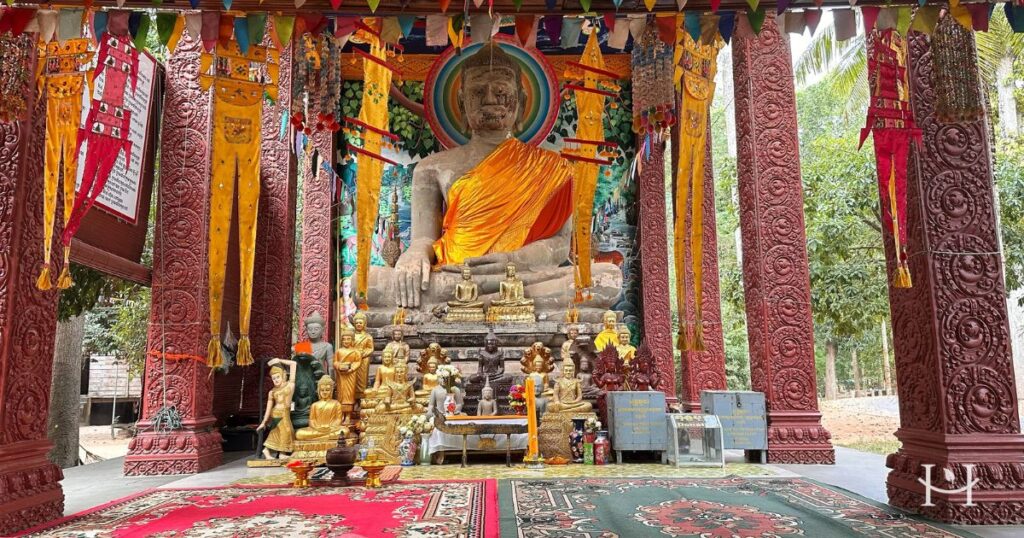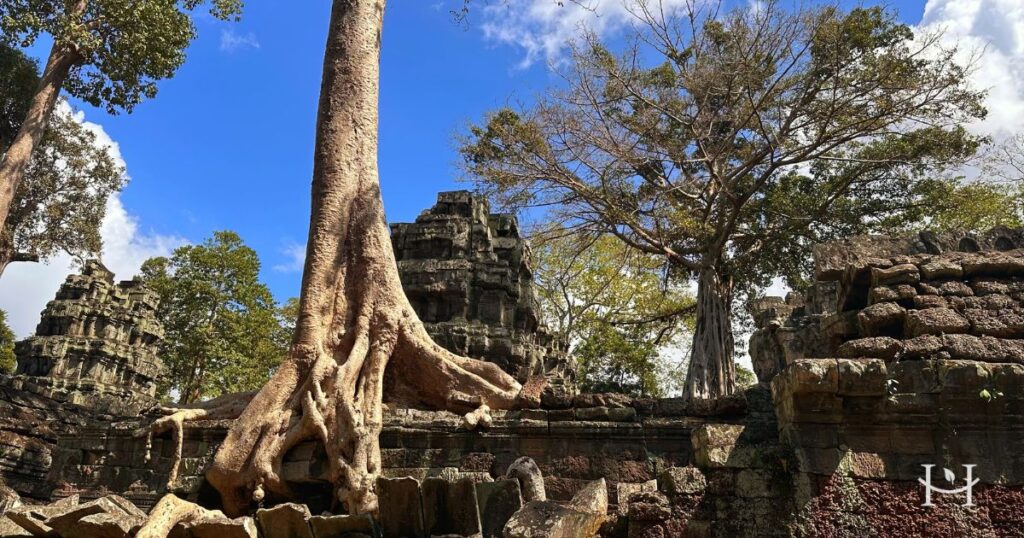A practical guide for travelers visiting the Angkor Wat temple complex in Siem Reap, Cambodia Guaranteed: concise information for visitors to Siem Reap and those visiting the Angkor complex, and subjective recommendations on places I think are worth seeing – I don’t duplicate popular lists.
CONTENTS – go to specific questions and answers:
- Angkor Wat – is it worth visiting? Introduction to the guide.
- Angkor Wat – where Siem Reap is located and how to plan your stay.
- Visiting Angkor Wat and the Angkor complex – everything you need to know.
- Go to information about selected temples
(highlights, Google pins, distance from Angkor Wat, tour time, interesting facts):- Angkor Wat – city of temples, sunrise
- Angkor Thom South Gate + Prasat Bei – beautiful gate and bridge
- Bayon Temple – faces in the stones
- Terrace of the Elephants – stop for elephant statues
- Preah Khan – western entrance with beautiful bridge, giant trees
- Neak Poan – a stop on an artificial island
- Preah Rup – 2-story temple, possibility to climb to the top
- Ta Prohm – temple for scenes in Tomb Raider, my number 1!
- Phnom Bakheng – sunset viewpoints
- Additional attractions in Siem Reap:
- Floating Village
- Angkor Center for Conservation of Biodiversity – wildlife conservation park
- Kulen Waterfall
1 Is Angkor Wat worth seeing?
Definitely yes! The town of Siem Reap itself, did not appeal to me. However, in the Angkor complex I felt like I had reached the lost city. You absolutely must visit this location. Magic!
Angkor Wat is the largest of the temples in theAngkor complexit was built in the 12th century. It is located in Siem Reap, located in the northwestern part of Cambodia. Angkor Wat translation means City of Temples. The shrine, along with the nearby 72 temples, is part of Angkor Archaeological Park, an area of 163 hectares. The structures were built during the reign of the Angkor Empire (otherwise known as the Khmer Empire) between the 8th and 15th centuries. The site is listed on The Guinness World Records as the largest religious monument in the world.
Angkor Wat was built to honor the Hindu faith, but by the end of the 12th century there was a transformation of faith to the Buddhist.
! For ease of navigation in the article, I refer to the Angkor complex as Angkor Wat. However, I remind you that this is only the name of the main temple.
List of the most important temples in the Angkor complex HERE.
2 Formalities – when to visit, how to get there and plan your stay in Siem Reap
Siem Reap is located in the northwestern part of Cambodia, home to about 200,000 people.
Angkor Wat in Siem Reap - when to visit?
|
Month |
WEATHER | |
| Precipitation: | Temp. | |
| January | ☀️ |
31-33°C |
| February | ☀️ | |
| March | ☀️ |
32-34°C |
| April | ☂️☂️ | |
| May | ☂️☂️ | |
| June | ☂️☂️☂️ | |
| July | ☂️☂️☂️ | |
| August | ☂️☂️☂️ | |
| September | ☂️☂️☂️ | |
| October | ☂️☂️☂️ | |
| November | ☀️☂️ |
29-30°C |
| December | ☀️☂️ | |
The dry season in Siem Reap, Angkor Wat:
The dry season lasts from November to March – that is, during the winter in Europe. The climate during this period is the most optimal – slightly lower temperatures. The best time to visit Angkor Wat is November-December. With the beginning of the year, temperatures rise significantly.The rainy season in Siem Reap, Angkor Wat:
The rainy season lasts from April to October – higher temperatures average 32 – 34°C, rainfall optimal in the first months, apogee occurs from June to October.Transportation to Siem Reap
**All prices quoted in the article are current as of January 5, 2024.
The nearest airport in Siem Reap is 45 km from the center (there is a second one directly in the city, but it is closed), from where you can hire direct transportation. I recommend installing two apps: Bolt or Grab, as local cabs, including those under the airport, charge much more. Depending on the time and day, the price of TukTuk transportation to the center varies between 55,000 and 100,000 RIEL = 14 USD – 25 USD (late in the evening, unfortunately, will be the upper end price).
Transportation and accommodation in Siem Reap
Transportation on your own: I recommend renting a scooter, prices depend on the rental time. It is also possible to rent a bicycle, but I do not know the prices, and in my opinion in traffic here is impractical.
RECOMMENDATION – SCOOTER RENTAL
In DYNE SCOOTER I rented a scooter from a very nice family.
Scooter rental price: day / 10 USD, week / 40 USD, month 70 – 80 USD.
TukTuk – price for a ride to Angkor Wat temple: 10,000 – 16,000 RIEL (2.5 – 4 USD) after the city itself 5000 – 10,000 RIEL = 1.25 – 2.5 USD)
How far is Angkor Wat from Siem Reap?
Angkor Wat belongs to the city of Siem Reap, the complex is 6 km from the center. You can reach it by rented scooter or book a one-time or full-day TukTuk [GRAB lub rezerwacja przez biuro]
Do I need a visa to visit Cambodia?
Yes, however a Visa on Arrival for 30 days is available for a fee of 35 USD for a foreigners. [LISTA KRAJÓW]
Places in Asia I recommend to visit:

16 Amazing Things to Do on Koh Phangan Beyond Full Moon Party
Tourists visiting Koh Phangan often make the mistake of focusing only on the local Full Moon Party. Yet, the island boasts a wealth of other fascinating, unique attractions, events, and experiences—Koh Phangan hidden gems—that are

Camping on Langkawi Island: A 6-Tip Guide for an Unforgettable Week
Drawing from the guide below, I welcome you to explore the allure of Langkawi Island in Malaysia. My week there was memorable, filled with camping on a stunning sandy beach. Picture your mornings beginning with
3 How to plan a tour of Angkor Wat and the Angkor complex.
Angkor Wat – where to buy entrance tickets:
You can buy entrance tickets to Angkor Wat at the point of sale or ONLINE.
- entrance ticket to the temples is a full-day ticket, it entitles you to visit all the temples within Angkor Archaeological Park
- Angkor Wat entrance ticket is free for children under 12 years old
- Angkor Wat tickets online (don’t waste time in lines)
- when buying online, you must indicate the starting date
- multi-day passes are activated at checkpoints
- the ticket is named, not transferable – with your photo on it
Angkor Wat available passes and prices:
1-day: $37 | valid for 1 day
3-day: $62 | valid for 7 days
7-day: $72 | valid for 30 days
Angkor Wat is open year-round, but monitor opening and closing hours.
Angkor Wat 5:00 am – 5:30 pm,
rest of the temples usually 7:30 am – 5:30 pm
Recommendation:
The complex is huge, 1 day is far too short to realistically see even half of the complex. If you have time – buy a 3-day ticket
Angkor Wat – rules for visiting temples and the Angkor complex
GENERAL RULES for visiting Angkor Wat:
- respect others and maintain regulated silence, if you take video – do it subtly
- monks – treat with respect, don’t take pictures without asking permission first!
- don’t touch – sculptures and ornaments
- Can you fly a drone over Angkor Wat? No, it is forbidden
- Monkeys – do not feed or touch, they steal and bite
Angkor Wat – dress code for men:
- covered shoulders
- wear a classic t-shirt with regular sleeves (can’t be too short) or a shirt
- tank tops are forbidden, if you wear one, take a t-shirt to the complex for a change of clothes or wear a shirt over it
- covered knees
- wear long pants or:
- short shorts are allowed, but long enough to cover the knees
Angkor Wat – dress code for women:
Women are bound by the same rules as men
- covered shoulders and shallow necklines
- a subdued dress is allowed
- covered knees
- skirt and short shorts are allowed, but long enough to cover the knees
Tailor the tour plan to your expectations
The most important thing is to have a tour plan and answer some questions:
- How many days do you plan to stay in Siem Reap?
-> I suggest a minimum of 3 days, including an entrance ticket for 3 days. You won’t even see 1/3 in 1 day. - What “attractions” are you most interested in?
-> by resort maps (map below)
-> selected the most interesting (in my opinion) list: - Do you care about unique photos / video?
-> start your tour at opening: 5:00, less people - Interested in learning more about the history in detail?
-> hire a guide with TukTuk - What form of sightseeing do you prefer – on your own or
organized?
-> yourself – use my guide
-> organized – buy a trip from a travel agency
Transportation between temples in Angkor Wat
The temples are 1-3 km apart, so I recommend renting a scooter or a TukTuk driver to accompany you all day, transporting you between the temples. There is a parking space at each temple, so there any driver waiting for you.
Transportation on your own:
- rented scooter (USD 10 / day)
- bicycle (? USD / day)
Organized transportation:
- rented all-day TukTuk (15 USD)
Recommendation:
I personally recommend transportation on your own – renting a scooter or bicycle. Why? Because I have complete freedom, everything at my own pace, I feel like a backpacker, not a classic tourist. But what is more convenient for you.
Is it possible to explore without transportation?
Theoretically yes, but trust me, it takes 2 full days to see everything. The stretches between temples are large. The weather is tiring. It does not make any sense at all, transportation is necessary.
Organized tours
There are many offers where you have transportation and guided tours. Is it worth it? I think so – but I would verify prices with several travel agencies. You will also find guides locally. Many of them speak multiple foreign languages, which is a big plus.
Price of a one-day guided tour: 20 – 60 USD
Price of one-day rental of a TukTuk driver: 15 USD.
Angkor Wat – what route to take?
ANGKOR – small circle tour:
Angkor Wat
Angkor Thom South Gate
Bayon Temple
Baphoun
Ta Phrom
Banteay Kdei
Phnom Bakheng
ANGKOR – big circle tour:
Angkor Wat
Angkor Thom South Gate
Bayon Temple
Baphuon
Terrace of the Elephants
Terrace of the Leper King
Preah Khan
Neak Poan
Ta Som
Preah Rup
Ta Phrom
Banteay Kdei
Phnom Bakheng
4 List of the most important (objectively) temples:
Angkor Wat – city of temples
Date of origin: 12th century
Opening hours: 5:00 – 17:30
Tour time: 2 – 2,5h
Highlights: sunrise, size
My rating: 6.5/10
All the most important information about Angkor Wat, interesting and historical facts:
- built in the early 12th century
- location on the eastern part of the complex most likely means that the temple was created with dedication to death and the dead, and the site may have become a burial ground
- erected in the Hindu faith, converted to the Buddhist faith in the late 12th century
- construction took 30 years
- 300,000 laborers, 6,000 elephants worked on construction
- 5 to 10 million stones, weighing up to 1,500 kg, were used for construction
- the building material was transported by river, from Mount Kulen
50 km away - The Khmer Empire collapsed in the 15th century for unknown reasons, it is assumed that either due to climate change or enemy invasion
- Angkor Wat is the symbol used on the Cambodian flag and banknotes
- Angkor Wat is often referred to as the 8th wonder of the world, but this is not an official title obtained
Tips:
- for sunrise and good photos, appear at 4:50 am before entering
- best spot for photos: in front of the pond (the one behind the wall), on the right side, about ¾ of the pond wide (all towers visible)
- the earlier, the cooler and less crowded it is
Sunrise over Angkor Wat:
A popular attraction here is the sunrise, which rises from behind the complex. That’s why crowds gather in front of the pond over which the bridge runs. By taking photos or timelapse at this spot, you can get beautiful shots of the 800-year-old monument, which, along with the surrounding palm trees – is reflected in the surface of the water.
Angkor Wat – travel souvenirs – photos
Be warned, huge crowds of tourists appear there, if you want to take good shots – you must arrive at 4:50 and wait in line for the area. At 5:10, the entire bank of the pond will already be surrounded by several rows of visitors. Is it worth it? I’ve been 3 x and it’s worth it, but as long as you set up a tripod to record a time lapse and then focus on experiencing the view, if you only care about photos – you may be disappointed.
There are many photographers in the complex. I was alone, I was accosted by several and refused, but I was finally convinced by one of them. One photo costs $1, but be careful – they will take you 50 of them and try to get that many. Before they rip the photos for you on your phone (they have special switches) select only the ones you are interested in and then pay. If you prefer to take the photos yourself – watch where they do the sessions – they know super places, shots.
Prasat Bei - stop in front of the gate
Date of origin: 10th century
Opening hours: 7:00 – 17:30
Visiting time: 30 min
Distance from Angkor Wat: 2 km
highlights: tour in seclusion of 2 small temples, next to a bridge with a spectacular gate
My rating: 6/10
There is nothing interesting about this temple in my opinion, except for the fact that there are often no tourists there and you can spend a while alone. A little closer to the entrance is an additional “pyramid”, more interesting than the main one. I recommend only for a rest, a stop with a snack between temples.
Angkor Thom South Gate – spectacular bridge and gate
My rating: 8/10
Continuing along the roadway, we cross a bridge with well-preserved statues in the silhouettes of people, and this leads to a spectacular gate with faces pointing in 4 directions of the world. Before noon, the whole thing is subtly illuminated, and we can see the moat in the background – the whole thing is super impressive. A must-see it!
Bayon Temple – a spectacular temple with monumental faces
Date of origin: 12th / 13th century
Opening hours: 7:30 – 17:30
Tour time: 1,5 – 2h
Distance from Angkor Wat: 3.5km
Highlights: monumental smiling faces, nice views, Buddha statue, monkeys
My rating: 10/10
A must-see it! A must-see item! I personally think that this temple beats Angkor Wat. What sets it apart is the motif of monumental smiling faces that adorn the numerous towers, each dedicated to one direction of the world. There are as many as 173 faces in total!
I recommend arriving a while after opening (7:30) when there are no tourists yet. The place is visually enchanting and atmospheric. I had the impression that I ended up in an ancient abandoned city.
Outside the temple, two additional attractions: 2 places of prayer, where 1 quite ordinary, 2 much more interesting with a nice arrangement.
There are quite a few monkeys living by the toilets. There are always a lot of onlookers who sit in a semi-circle and photograph the 3 monkeys for hours. If you get past them and sidle closer to the jungle – there you can watch the whole family, of different ages, in peace. I recommend, but hide any food, drinks – they steal.
Tips:
- it’s worth visiting right after opening to avoid crowds
- pay attention to details – faces, beautiful shots of the whole temple from afar – from behind the moat
- hide food in plain sight – monkeys
Terrace of the Elephants – stop for elephant statues
My rating: 5/10
The remains of a dilapidated temple. Not much to explore, worth stopping for 5 minutes only to see the elephant statues.
Preah Khan – western entrance
Date of origin: 12th century
Opening hours: 7:30 – 17:30
Sightseeing time: 0.5 – 1h
Distance from Angkor Wat: 6.5km
Highlights: trees innate in the walls, more austere atmosphere around.
My rating: 8/10
I recommend entering from the west side, as there is a bridge leading to it with statues that “hold the bridge”. There is a moat in the background and a foretaste of what you will see later – trees growing into the walls. This place is not reached by many tourists, so visit in peace and quiet. A beautiful view from the bridge to the gate, with the moat in the background.
Neak Poan – a stop on an artificial island
My rating: 6/10
Unfortunately, I was not satisfied, the place is very ordinary. However, I recommend for a stop and rest. After crossing the bridge, a moment before turning to the temple, it is possible to walk to the “pier”. On the length of probably a kilometer every now and then there are benches set up, where it is worth resting and calming down.
Preah Rup – view from the 2nd floor
Date of origin: 10th century
Opening hours: 7:30 – 17:30
Visiting time: 30 – 45 min
Distance from Angkor Wat: 8 km
Highlights: you can go up to the 2nd floor, different style, red stone, less touristy
My rating: 7/10
A temple worth a stop because it was built in a slightly different style than the rest. Built of stone with a red hue. Possibility to climb to the 2nd floor, which, combined with the nature surrounding the building, creates an interesting scenery, accompanied by a mass of sounds of animals living in the jungle.
Ta Prohm – a temple from the scenes in Tomb Raider, my number 1!
Date of origin: 12th century
Opening hours: 7:30 – 17:30
Czas zwiedzania: 1 – 2,5h
Distance from Angkor Wat: 8.2km
Highlights: giant trees growing out of the walls, “lost city” atmosphere, no human interference, place “reclaimed by nature”, MUST HAVE
My rating: 10/10
My favorite part of the trip, a place I visited 5 times and each time I discovered something new. At this temple we have an example of how nature reclaims its power. the movie Tomb Raider. Giant trees that literally grew on the walls, entwining the stones with a huge root system. We’re talking about the Five-Trunked Puffball, which reaches heights of up to 70 meters, with a trunk as high as 3 meters. Now imagine that 20 of these have sprouted from the entire temple area… Something amazing.
In the background you can hear all sorts of animals, and at times you have the impression that some dinosaur will jump out from around the corner. An unusual place. Here it is interesting that the scenery of this place was used in
Phnom Bakheng - sunset viewpoints
Date of creation: 9th century
Opening hours: 7:00 – 18:30
Visiting time: 45 min
Distance from Angkor Wat: 1.5 km
Highlights: sunset, short climb, 2 impressive viewpoints
My rating: 7/10
In my opinion, nothing extraordinary compared to other temples, however, it is worth visiting in the afternoon, around sunset. There are 4 viewpoints, 2 of them with a 15-minute worth of climbing – landscape, at the last one Angkor Wat is visible, often with a light mist.
Everyone heads to the top of the temple to watch the sunset, I recommend resting in less besieged vantage points.
5 Plus: worth seeing in Siem Reap
What other attractions can we find here? When planning your stay, it’s really worth it to manage the extra time at 3 points away from the center:
Floating Village - a village flooded during the rainy season
A village called Floating Village is located on the river. The name comes from the fact that during the rainy season, the amount of rainfall is so abundant that the water level here rises by as much as 3 meters. As a result, the local community has adapted to the conditions by building houses on wooden elevations reaching 2-5 meters. The view is remarkable, because when visiting the place in the dry season, we can see how the space below is managed, which until the rainy season is simply a road.
The village has a population of 2,500, where multi-generational families of up to about 10 people have to accommodate themselves in small houses. There is no access to running water, sanitation or health care due to the flooded land. Cultivation time is also limited. As a result, there is appalling poverty.
Along the way you can observe the main source of local food and also income – fishing. Long nets, rolled via special machines that drop fish, shrimp from the net.
I recommend buying a tour with a guide, who tells you a lot about the local community. You can get there on your own, but in the end you will save a gross of a few dollars, as there is an entrance fee – often different if outside the travel agency.
Price: $16, which includes:
- transportation to the village by bus
- crossing the river along the village by boat
- Kampong Phluk – underwater forest and 30-minute tour by small boat (additional $6 USD)
- sunset on the river
- crocodile farm – a sad sight, 6 adult crocodiles in a very small space of 8 sqm….
Angkor Center for Conservation of Biodiversity – wildlife conservation park
Wild animals that are either injured and in need of veterinary care or have been rescued from captivity are rescued here. In particular, there are very interesting species of birds, monkeys and many different types of turtles.
The center operates, thanks to donations, so when deciding to visit – it is worth supporting with a donation. The center is guided by a guide who tells the story of the rescued animals and about the activities of the center itself.
I definitely recommend it!
Kulen waterfall – waterfall next to the Protection Park
The entrance to the trail to the waterfall is right next to the Conservation Park. The path is not difficult, part of it leads through stairs, part on a slight rise. It takes about 30 – 45 minutes to reach the waterfall. Along the way there is a beautiful view of the surrounding area.




































